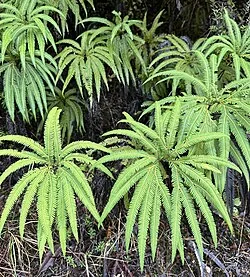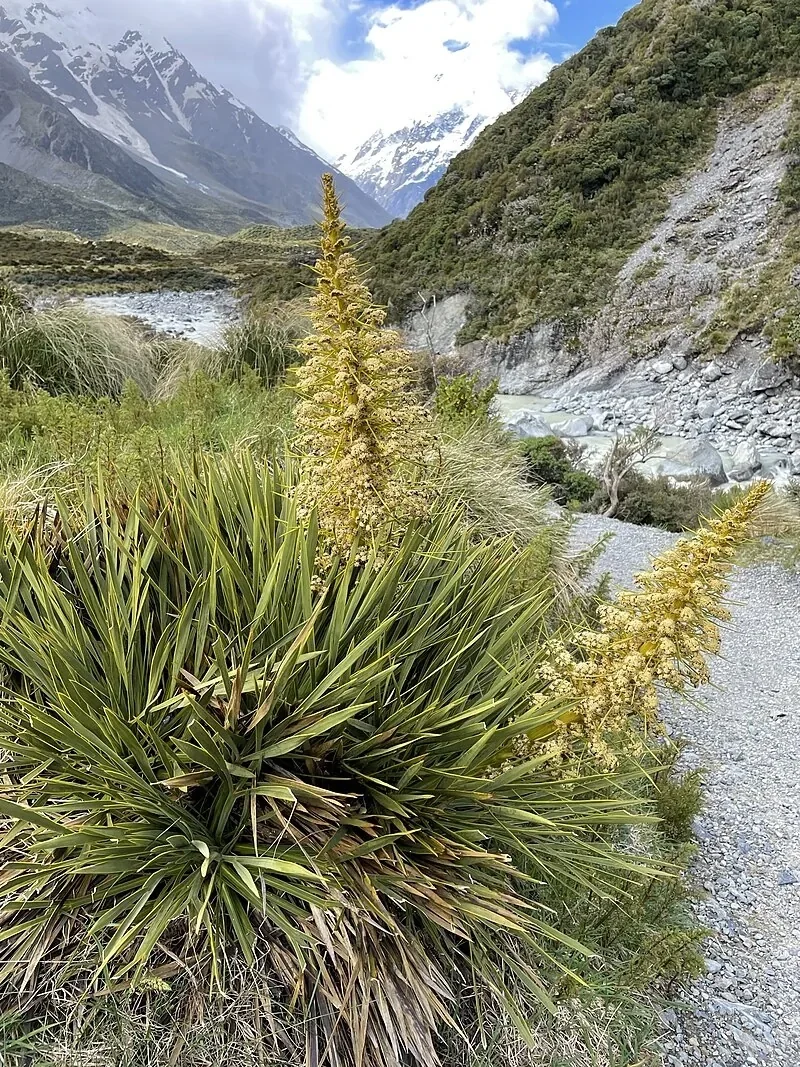
Waekura
Sticherus cunninghamii
Sticherus cunninghamii is a native New Zealand fern species . It is characterized by its distinctive fan-like fronds. Further detailed information about its specific characteristics will be added soon.

Plant Description
Sticherus cunninghamii (umbrella fern, waekura) is an elegant fern with fronds that fork repeatedly into flat, umbrella-like fans held on wiry, black stipes-creating layered tiers in humid shade.
Quick Facts
Key Characteristics
| Scientific Name | Sticherus Cunninghamii |
|---|---|
| Common Name | Waekura |
| Plant Type | Fern |
| Height | 20-50 cm (8-20 inches), fronds up to 1.4 meters |
| Spread | Up to 1 meter |
| Water Needs | Consistent moisture, high humidity (40-70%), moderate drought tolerance |
| Light | Partial sun to bright indirect light |
| Frost Tolerance | Hardy to -6.7°C (20°F), frond damage possible |
| Salt Tolerance | Information not available |
| Growth Rate | Moderate (long creeping rhizome) |
| Lifespan | Perennial, evergreen |
| Fronds | Fan-like |
| Habitat | Native to New Zealand |
Climate Best Suited to
Humid, frost-free to light-frost bush with constant moisture and filtered light; shelter from wind is essential.
Regional Suitability
| City | Climate Suitability |
|---|---|
| Whangārei | Ideal |
| Auckland | Ideal |
| Hamilton | Ideal |
| Tauranga | Ideal |
| Rotorua | Ideal |
| Gisborne | Ideal |
| New Plymouth | Ideal |
| Napier | Ideal |
| Whanganui | Ideal |
| Palmerston North | Ideal |
| Wellington | Ideal |
| Nelson | Ideal |
| Christchurch | Ideal |
| Dunedin | Ideal |
| Invercargill | Ideal |
Natural Habitat
Moist, sheltered forest and stream gullies from lowland to montane regions.
Umbrella fern forms layered fans in high-humidity bush where filtered light, constant seepage and deep leaf litter allow crowns to expand. It anchors to banks and rotting logs, creating tiered canopies over filmy ferns and bryophytes in the coolest parts of the forest.
Plant Conservation
Overview
Sticherus cunninghamii , also known as umbrella fern, is a fern endemic to New Zealand. The NZPCN indicates that it is "Difficult-should not be removed from the wild," suggesting a conservation concern. The NZPCN website also lists its current and previous conservation statuses.
Growing Requirements
Waekura thrives in cool, humid shade with free‑draining, humus‑rich media that never dries out completely. Provide constant moisture through regular misting and deep organic mulches, but avoid waterlogging around the rhizomes. Best in bright, indirect light (no direct midday sun), sheltered from wind. Ideal mixes use fine bark, leaf mould and pumice to balance aeration and moisture. Maintain high ambient humidity (60-90%) for pristine frond expansion.
Planting Guide
Best Planting Practices
Site plants beneath tree‑fern canopies, beside shaded water features, or in sheltered ferneries. Prepare wide planting pockets and amend with fine bark and leaf litter to mimic forest duff. Set crowns just at surface level and firm gently. Water to settle, then mulch with damp sphagnum or fine bark to stabilise humidity. In containers, use a shallow, broad pot to accommodate creeping rhizomes; water with rainwater where possible to avoid mineral build‑up.
Ecology
A characteristic understory fern of moist gullies and cloud‑forest margins, waekura forms layered, fan‑like fronds that intercept diffuse light and shed drip. Creeping rhizomes bind leaf litter on banks and rotting logs, creating microhabitat for filmy ferns ( Hymenophyllum ) and bryophytes. Spore‑dispersed and wind‑pollinated, it contributes to shaded ground cover and stabilisation in high‑humidity forest systems.
Uses
Specialist feature for humid shade gardens, conservatories, and fern collections requiring high-maintenance display specimens.
Waekura serves as a dramatic architectural element in specialist shade gardens where its distinctive tiered growth habit creates striking visual interest. Ideal for humid conservatories, ferneries, and protected courtyards where its specific environmental needs can be met consistently. The fern's unique umbrella-like form makes it valuable for collectors of rare native species and botanical specialists seeking authentic New Zealand forest understory plants.
Landscaping Ideas
Combine with filmy ferns, native mosses, and Hymenophyllum species in sheltered fernery displays that showcase New Zealand's unique understory flora.
Create atmospheric woodland scenes by grouping waekura with other moisture-loving natives in protected courtyards or beneath tree ferns where humidity naturally accumulates. Partner with Asplenium bulbiferum , Adiantum species, and prostrate mosses to recreate authentic forest floor communities. The fern's architectural form provides stunning contrast when planted near water features where gentle misting maintains ideal humidity levels.
Seasonal Care
Spring
New growth emerges; increase misting frequency as temperatures rise and maintain consistent humidity around developing fronds.
Summer
Peak growing season requires regular watering and maximum humidity; provide deep shade during hottest periods to prevent frond scorch.
Autumn
Reduce watering frequency as growth slows; collect mature spores for propagation if attempting spore-based reproduction.
Winter
Minimal watering but maintain humidity levels; protect from frost and cold winds; ideal time for dividing established clumps.
Pruning
Pruning Techniques
Remove damaged or diseased fronds at base; avoid cutting healthy growth as regeneration is very slow.
Waekura requires minimal pruning due to its slow growth rate and delicate structure. Remove only brown, damaged, or diseased fronds by cutting cleanly at the base with sterile secateurs to prevent infection. Never trim healthy green fronds as this severely stresses the plant and recovery can take years. Tidy browning frond tips carefully without cutting into healthy tissue, as this species is particularly sensitive to pruning damage and responds poorly to heavy cutting.
How to Grow Waekura
Waekura requires specialized propagation techniques that replicate its natural habitat conditions. This umbrella fern thrives in high humidity environments with consistent moisture and filtered light. Successful propagation demands patience and attention to maintaining the humid, cool conditions this species naturally prefers in New Zealand's forest understory environments.
Spores
Umbrella fern reproduces naturally through spores produced on the undersides of mature fronds, appearing as small brown clusters when ready for collection. Collect mature spores during late summer to autumn when they are fully developed, measuring 29-31 μm by 14-15 μm. Sow fresh spores immediately onto a sterile, moisture-retentive growing medium such as finely chopped sphagnum moss or specialized fern compost, covering very lightly with fine sand or vermiculite. Maintain consistently high humidity by covering with glass or plastic to create a mini-greenhouse effect, keeping temperatures around 15-20°C in bright, indirect light away from direct sun. Germination is slow and may take several months, requiring patience and consistent moisture management. Once prothalli develop and young sporophytes appear, gradually reduce humidity levels while maintaining steady moisture until plants are large enough to handle.
Division
Established Waekura clumps can be carefully divided during early spring as new growth begins, though this method requires extreme care due to the sensitive rhizome system. Select mature plants with well-developed rhizomes and multiple growing points, using sharp, sterile tools to separate sections ensuring each division retains adequate roots and growing tips. The long creeping rhizomes are much-branched and covered with dark brown scales, making clean division challenging but achievable with patience. Plant divisions immediately into humid, well-draining mix with high organic content, maintaining consistent moisture without waterlogging. Provide shelter from wind and direct sun while divisions establish, which may take a full growing season. Success rates are generally lower than spore propagation, making this method suitable only for experienced growers.
Establishment Care
Young Waekura plants require meticulous care during their first two years, replicating the cool, humid forest floor conditions of their natural habitat. Provide consistent humidity levels of 60-80% through regular misting or humidity trays, while ensuring good air circulation to prevent fungal issues. Maintain soil moisture without waterlogging, using a well-draining mix rich in organic matter such as composted bark, leaf mould, and coarse sand. Feed sparingly with diluted liquid fertilizer during the growing season, as excessive nutrients can damage the delicate root system. Protect from temperature extremes, maintaining steady conditions between 10-20°C with protection from frost and hot, dry winds. Monitor for signs of stress such as browning frond tips or stunted growth, adjusting humidity and watering regimes accordingly.
Pests and Diseases
Common Problems and Solutions
While generally resilient when provided with appropriate growing conditions, waekura can be affected by several common problems that require prompt attention and management. Slugs and snails represent the most significant pest threat to waekura, particularly during damp periods when these mollusks are most active and can cause devastating damage to tender new fronds by shredding delicate tissue. Deploy comprehensive slug and snail control measures including beer traps, copper barriers, organic pellets, and habitat modifications that encourage natural predators such as ground beetles, birds, and other beneficial organisms. Regular monitoring during humid conditions is essential for early detection and intervention before populations become established. Browning of frond tips and edges typically indicates environmental stress, most commonly low humidity or drought conditions that stress the moisture-loving fern. Address browning promptly by increasing humidity levels through misting, improving mulching, and ensuring consistent soil moisture to prevent further deterioration. Stale, still air around plantings encourages fungal spotting and other disease issues, particularly during warm, humid conditions when air circulation is reduced. Improve ventilation around plants by strategic pruning of surrounding vegetation, positioning plants to benefit from natural air movement, and avoiding overcrowding that restricts airflow. Scale insects may occasionally infest waekura, appearing as small brown bumps on fronds and stems that gradually weaken plants by extracting sap. Treat scale infestations with horticultural oil applications or systemic organic treatments, ensuring thorough coverage of all affected plant surfaces for effective control.
Cultural Significance
Traditional Uses and Values
Known to Māori as waekura, this elegant umbrella fern is associated with cool, humid forest places and is regarded as a tohu (indicator) of healthy, continuously moist ngahere (forest) understory. While its delicate, fan‑shaped fronds are not suited to durable weaving, they have traditionally been gathered as decorative greenery for ceremonial and domestic settings, and to evoke the damp, shaded character of spring‑fed bush. The plant's presence alongside filmy ferns and mosses reflects long‑standing relationships between people and the hydrology of valley floors, gullies and cloud‑forest margins.
In contemporary gardens, waekura is often used as a teaching species to illustrate the importance of shelter, humidity and permanent moisture in recreating forest microclimates. Its layered fronds also provide habitat structure for invertebrates and small forest fauna, reinforcing mātauranga Māori perspectives that emphasize interconnectedness within the ngahere.
Bonus Tip
Expert Growing Advice
Use collected rainwater rather than tap water in hard‑water areas, and set the pot on a wide humidity tray filled with damp pumice or pebbles so fronds never dry after warm, windy days. Keep the crown at the original height and avoid lime or high‑salt fertilizers - waekura prefers low‑nutrient, slightly acidic mixes with constant, gentle moisture and moving air.







